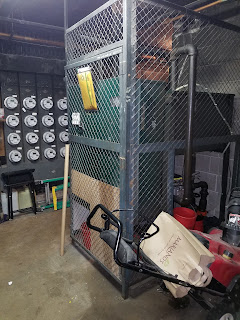Elevator
Modernization – Downers Grove Park District – Downers Grove, IL
We
recently had the opportunity to partner with the Downers Grove Park District to
work on replacing their 45 + year old elevator.
The existing elevator was a 1970’s vintage ESCO elevator that was having
reliability issues servicing this busy building. The building hosts a plethora of activities
for babies, toddlers and seniors. In
the mornings this is busy with strollers and walkers to wagons and canes. Time line was tight. Here is how it came out.
Existing
equipment
Controller
– ESCO relay logic
Door
operator – GAL MOD
Power
unit – ESCO with EECO UV5A valve
Fixtures
– Dover
New
equipment
Controller
– MCE Motion 2000
Door
operator – GAL MOVFR w/GAL hatch and car equipment
Power
unit – MEI w/Maxton UC4 valve
Fixtures
– Innovation
Car
and hatch doors – MEI car doors
Car
interior – Cabworks
Roller guides - Elsco
Fire recall - Chicago Metro Fire
Cab interior
[Old elevator interior]
[Old ceiling & lighting]
[New elevator interior]
[New elevator interior]
[New elevator ceiling & lighting]
Elevator interior - We partnered with Cabworks to give the building a new interior. A lot of times this is the only item a building notices, cab interiors. The interior came out great. Colley installed new MEI stainless steel #3 car doors and Cabworks did the rest.
Machine room
[Old machine room]
[New machine room]
Machine room - We where able to utilize the back of the elevator machine room that used to be a coal shoot. It since has been bricked in. Now there are no electrical clearance issues and you have a ton of space in the new machine room.
Elevator controller
[Old ESCO Elevator Controller]
[New MCE 2000 Hydraulic elevator controller]
Elevator control system - You can see the difference 45 years of elevator controller technology. The ESCO relay logic versus the Motion Control Engineering[MCE] solid state control system.
Elevator car fixtures
[Old ESCO car station]
[New Innovation car station]
Elevator car station - We removed the old car station and installed a new Innovation car station. The look is complemented by the new cladding by Cabworks. This is a unique cab where the car station is on the side wall as this is front and rear openings. Typically the car station would be on the door return but the returns where both too shallow to fit the car station box.
Elevator hall stations
[Old 1st floor hall station & P/I]
[New 1st floor hall station & P/I]
Hall stations - This was a unique set up. The hall stations where lower than ADA initially so we had to compensate for the buttons being lower with the hall station plate. Each floor had a hall position indicator. So instead of plating them we put a new P/I and hall lanterns to fit in the old boxes.
Elevator door operators
[Old GAL MOD door operators]
[New GAL MOVFR door operators]
Door operators - The specification called for all new door operators, new door tracks, car and hatch equipment. All new GAL equipment was installed.
Hydraulic power unit
[Old ESCO power unit with a newer EECO UV5 valve]
[New MEI power unit with a Maxton UC4 valve]
Power unit - This was a typical power unit replacement except the specification called for this 50 foot per minute car to go 100 feet per minute. The request was not possible as the power supplying the power unit was only able to support a 75FPM car. So they got a little larger motor, little faster elevator. If a 100FPM power would have been installed the breaker would have continually tripped due to amp draw issues. This is something everyone should know but we don't always pay attention, always check your ampacity and power feed prior to sizing your power unit.
Project overview - This was a fun project to work on from the design side with the fixture challenges and car speed change. It was also a challenging one for the team that was doing the installation due to the remote machine room, wire count and all the devices outside and inside the hoistway[front and rear, hall lanterns, P/I's, etc.]
The
project was a public bid and the Park District saved a considerable amount of
money from the other two bidders bids.
As
always feel free to contact us at www.colleyelevator.com,
email Craigz@colleyelevator.com or call 630-766-7230.




































